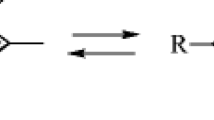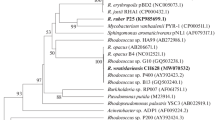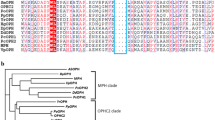Abstract
Biphenyl dioxygenase (Bph Dox) catalyzes the initial dioxygenation step in the metabolism of biphenyl. The large subunit (BphA1) of Bph Dox plays a crucial role in the determination of the substrate specificity of biphenyl-related compounds including polychlorinated biphenyls (PCBs). Previously, the substitution of Asn at Thr-376 near the active-site iron in the BphA1 of Pseudomonas pseudoalcaligenes KF707 expanded the oxidation range and altered the regiospecificity of Bph Dox for PCBs. In this study, we replaced Thr-376 with Gly, Ser, Gln, Tyr, Val, Phe, Asp, and Lys and expressed these enzymes in Escherichia coli. Bph Dox mutants of Thr376Asn, Thr376Val, Thr376Phe, and Thr376Lys showed novel degradation activity for dibenzofuran, which is a poor substrate for KF707 Bph Dox. All active Bph Dox mutants showed altered regiospecificity with 2,2′-dichlorobiphenyl and 2,5,4′-trichlorobiphenyl. The Thr376Gly, Thr376Val, Thr376Phe, and Thr376Asp Bph Dox mutants introduced molecular oxygen at the 2,3 position of 2,2′-dichlorobiphenyl, forming 2-chloro-2′,3′-dihydroxybiphenyl with concomitant dechlorination. The Bph Dox mutants of Thr376Gly, Thr376Ser, Thr376Asp, and Thr376Lys attacked 2,5,4′-trichlorobiphenyl via both 2′,3′- and 3,4-dioxygenation activities. In particular, the Thr376Phe Bph Dox mutant exhibited enhanced and expanded degradation activities toward all of the compounds tested. Further site-directed mutation was induced to change the oxidizing character of KF707 Bph Dox to that of the Bph Dox of Burkholderia xenovorans LB400 by the substitution of two amino acids, Ile335Phe and Thr376Asn, near the active-site.




Similar content being viewed by others
References
Abraham WR, Nogales B, Golyshin PN, Pieper DH, Timmis KN (2002) Polychlorinated biphenyl-degrading microbial communities in soils and sediments. Curr Opin Microbiol 5:246–253
Bak-Jensen KS, Andre G, Gottschalk TE, Paes G, Tran V, Svensson B (2004) Tyrosine 105 and threonine 212 at outermost substrate binding subsites −6 and +4 control substrate specificity, oligosaccharide cleavage patterns, and multiple binding modes of barley alpha-amylase 1. J Biol Chem 279:10093–10102
Barriault D, Plante M-M, Sylvestre M (2002) Family shuffling of a target bphA region to engineer biphenyl dioxygenase. J Bacteriol 184:3794–3800
Carredano E, Karlsson A, Kauppi B, Choudhury D, Parales RE, Parales JV, Lee K, Gibson DT, Eklund H, Ramaswamy S (2000) Substrate binding site of naphthalene 1,2-dioxygenase: functional implications of indole binding. J Mol Biol 296:701–712
Erickson BD, Mondello FJ (1992) Nucleotide sequencing and transcriptional mapping of the genes encoding biphenyl dioxygenase, a multicomponent polychlorinated-biphenyl-degrading enzyme in Pseudomonas strain LB400. J Bacteriol 174:2903–2912
Erickson BD, Mondello FJ (1993) Enhanced biodegradation of polychlorinated biphenyls after site-directed mutagenesis of a biphenyl dioxygenase gene. Appl Environ Microbiol 59:3858–3862
Fedi S, Carnevail M, Fava F, Andracchio A, Zappoli S, Zannoni D (2001) Polychlorinated biphenyl degradation activities and hybridization analyses of fifteen aerobic strains isolated from a PCB-contaminated site. Res Microbiol 152:583–592
Furukawa K (1982) Microbial degradation of polychlorinated biphenyls. In: Chakrabarty AM (ed) Biodegradation and detoxification of environmental pollutants. CRC Press, Boca Raton, pp 33–57
Furukawa K (1994) Molecular genetics and evolutionary relationship of PCB-degrading bacteria. Biodegradation 5:289–300
Furukawa K, Suenaga H, Goto M (2004) Biphenyl dioxygenases: functional versatilities and directed evolution. J Bacteriol 186:5189–5196
Gibson DT, Cruden DL, Haddock JD, Zylstra GJ, Brand JM (1993) Oxidation of polychlorinated biphenyls by Pseudomonas sp. strain LB400 and Pseudomonas pseudalcaligenes KF707. J Bacteriol 175:4561–4564
Goris J, Vos PD, Caballero-Mellado J, Park J, Falsen E, Quensen JF III, Tiedje JM, Vandamme P (2004) Classification of the biphenyl- and polychlorinated biphenyl-degrading strain LB400T and relatives as Burkholderia xenovorans sp. nov. Int J Syst Evol Microbiol 54:1677–1681
Haddock JD, Horton JR, Gibson DT (1995) Dihydroxylation and dechlorination of chlorinated biphenyls by purified biphenyl 2,3-dioxygenase from Pseudomonas sp. strain LB400. J Bacteriol 177:20–26
Hegg EL, Que L Jr (1997) The 2-His-1-carboxylate facial triad-an emerging structural motif in mononuclear non-heme iron(II) enzymes. Eur J Biochem 250:625–629
Hernandez BS, Arensdorf JJ, Focht DD (1995) Catabolic characteristics of biphenyl-utilizing isolates which cometabolize PCBs. Biodegradation 6:75–82
Jiang H, Parales RE, Lynch NA, Gibson DT (1996) Site-directed mutagenesis of conserved amino acids in the α subunit of toluene dioxygenase: potential mononuclear non-heme iron coordination sites. J Bacteriol 178:3133–3139
Kauppi B, Lee K, Carredano E, Parales RE, Gibson DT, Eklund H, Ramaswamy S (1998) Structure of an aromatic ring-hydroxylating dioxygenase-naphthalene 1,2-dioxygenase. Structure 6:571–586
Keenan BG, Leungsakul T, Smets BF, Wood TK (2004) Saturation mutagenesis of Burkholderia cepacia R34 2,4-dinitrotoluene dioxygenase at DntAc Valine 350 for synthesizing nitrohydroquinone, methylhydroquinone, and methoxyhydroquinone. Appl Environ Microbiol 70:3222–3231
Kimura N, Nishi A, Goto M, Furukawa K (1997) Functional analyses of a variety of chimeric dioxygenases constructed from two biphenyl dioxygenases that are similar structurally but different functionally. J Bacteriol 179:3936–3943
Kumamaru T, Suenaga H, Mitsuoka M, Watanabe T, Furukawa K (1998) Enhanced degradation of polychlorinated biphenyls by directed evolution of biphenyl dioxygenase. Nat Biotechnol 16:663–666
Maeda T, Takahashi Y, Suenaga H, Suyama A, Goto M, Furukawa K (2001) Functional analyses of Bph-Tod hybrid dioxygenase, which exhibits high degradation activity toward trichloroethylene. J Biol Chem 276:29833–29838
Mondello FJ, Turcich MP, Lobos JH, Erickson BD (1997) Identification and modification of biphenyl dioxygenase sequence that determine the specificity of polychlorinated biphenyl degradation. Appl Environ Microbiol 63:3096–3103
Parales RE, Resnick SM, Yu C-L, Boyd DR, Sharma ND, Gibson DT (2000) Regioselectivity and enantioselectivity of naphthalene dioxygenase during arene cis-dihydroxylation: control by phenylalanine 352 in the α subunit. J Bacteriol 182:5495–5504
Pollmann K, Wray V, Hecht H-J, Pieper DH (2003) Rational engineering of the regiospecificity of TecA tetrachlorobenzene dioxygenase for the transformation of chlorinated toluenes. Microbiology 149:903–913
Seeger M, Timmis KN, Hofer B (1999) Regiospecificity of dioxygenation of di- to pentachlorobiphenyls and their degradation to chlorobenzoates by bph-encoded catabolic pathway of Burkholderia sp. strain LB400. Appl Environ Microbiol 61:761–768
Suenaga H, Nishi A, Watanabe T, Sakai M, Furukawa K (1999) Engineering a hybrid Pseudomonad to acquire 3,4-dioxygenase activity for polychlorinated biphenyls. J Biosci Bioeng 87:430–435
Suenaga H, Goto M, Furukawa K (2001) Emergence of multifunctional oxygenase activities by random priming recombination. J Biol Chem 276:22500–22506
Suenaga H, Watanabe T, Sato M, Ngadiman, Furukawa K (2002) Alteration of regiospecificity in biphenyl dioxygenase by active-site engineering. J Bacteriol 184:3682–3688
Taira K, Hirose J, Hayashida S, Furukawa K (1992) Analysis of bph operon from the polychlorinated biphenyl-degrading strain of Pseudomonas pseudoalcaligenes KF707. J Biol Chem 267:4844–4853
Xu D, Enroth C, Lindqvist Y, Ballou DP, Massey V (2002) Studies of the mechanism of phenol hydroxylase: effect of mutation of proline 364 to serine. Biochemistry 41:13627–13636
Zielinski M, Kahl S, Hecht H-J, Hofer B (2003) Pinpointing biphenyl dioxygenase residue that are crucial for substrate interaction. J Bacteriol 185:6976–6980
Author information
Authors and Affiliations
Corresponding author
Electronic supplementary material
S1
Amino acid substitution in BphA1 of Bph Dox by site-directed mutagenesis (PDF 5 kb)
Rights and permissions
About this article
Cite this article
Suenaga, H., Goto, M. & Furukawa, K. Active-site engineering of biphenyl dioxygenase: effect of substituted amino acids on substrate specificity and regiospecificity. Appl Microbiol Biotechnol 71, 168–176 (2006). https://doi.org/10.1007/s00253-005-0135-2
Received:
Revised:
Accepted:
Published:
Issue Date:
DOI: https://doi.org/10.1007/s00253-005-0135-2




